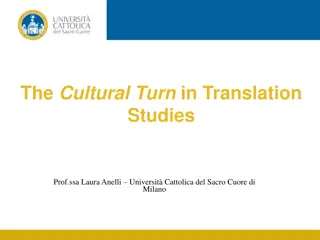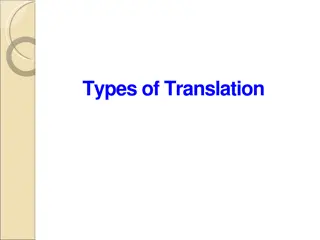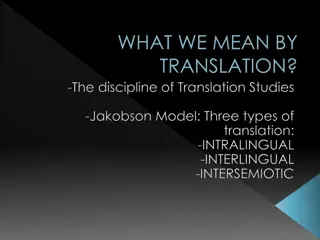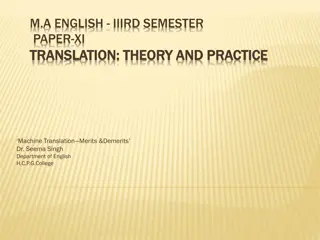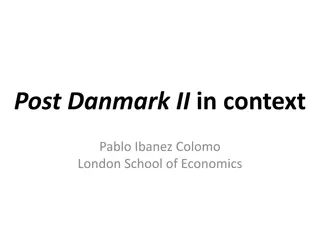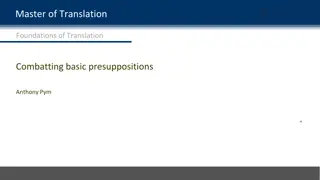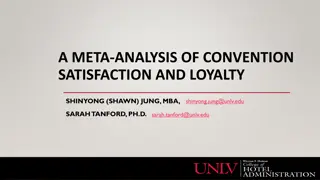Examining Loyalty in Translation: Perspectives and Implications
Exploring the concept of loyalty in translation studies through the lens of Christiane Nord's work, this content delves into the evolving definition of loyalty in the context of interpersonal relationships and social responsibility among translators. It compares fidelity with loyalty, discusses the shift towards functionalism and Skopos theory, raises questions about micro-level features, and emphasizes the importance of loyalty to both the source and target sides in translation practices.
Download Presentation

Please find below an Image/Link to download the presentation.
The content on the website is provided AS IS for your information and personal use only. It may not be sold, licensed, or shared on other websites without obtaining consent from the author. Download presentation by click this link. If you encounter any issues during the download, it is possible that the publisher has removed the file from their server.
E N D
Presentation Transcript
THE QUESTION OF LOYALTY
THIS WEEK Christiane Nord Function + Loyalty Translation as social action Moving towards culture
THE MOVE TOWARDS LOYALTY Fidelity is intertextual translation is interpersonal
LOYALTY VS FIDELITY Loyalty is not the old faithfulness or fidelity in new clothes. Faithfulness and fidelity referred to a relationship holding the source and the target texts as linguistic entities [...]. loyalty, on the other hand, is a category referring to a social relationship between people. It can be defined as the responsibility translators have toward their partners in translational interaction. (Nord 2001: 195)
FUNCTIONALISM & SKOPOS From ST-centred to TT-centred approaches From Text Types to Strategies Still focusing on a mainly linguistic notion of text and of translation Still encompassing notions of equivalence (see Semester 1) but focusing on what is functionally adequate
RETHINKING/CRITIQUING FUNCTIONALISM Too far from the ST? What about the micro-level features? Nord: what about multiple agents/actors and forms of loyalty? Loyalty commits the translator bilaterally to both the source and the target side.
LOYAL TO WHOM? Source Text author Other agents/actors (client, editor, ) Target Text users
NORD It was argued that translators, as mediators between two cultures, have a special responsibility with regard to their partners, ie the source text author, the client or commissioner of the translation, and the target-text receivers, particularly in cases where there are discrepant views as to what a good translation is or should be. As an interpersonal relationship, loyalty was meant to replace the traditional intertextual relationship of faithfulness or fidelity , concepts that usually refer to linguistic or stylistic similarity between the source and the target texts. (Nord 2001: p. 185)
HOW TO DO THIS loyalty can be achieved by making the translation strategies explicit in a preface, by adopting clear choices at points of source text ambiguity, and by using the most advanced theological and philological scholarship to ensure loyalty to the source-text author s intentions. (Nord 2001: 185)
LOYALTY AS AN ETHICAL MOVE: THE POWER/RESPONSIBILITY OF TRANSLATORS Translation and Ethics: see Anthony Pym, ed., The Return to Ethics , Special Issue of The Translator, Vol. 7/2, 2001)
NORD: the acceptability of translation purposes is limited by the translator's responsibility to all her or his partners in the cooperative activity of translation. Loyalty may oblige translators to reveal their translation purposes and justify their translational decisions. (Ibid., p. 10)
GREAT POWER, GREAT RESPONSIBILITY As the only one in the communicative game of translation who (by definition) knows both the source and the target cultures, the translator holds a powerful role. They could easily deceive their partners without anybody noticing sometimes even just by faithfully translating what the source text says [ ]. Seen in this way, loyalty may be a corrective in the powerplay between client, author, target receivers, and the translator. Christiane Nord, Manipulation and Loyalty in Functional Translation , Current Writing 14 (2) (2002), 32-44 (p. 36)
NOT ALL TRANSLATIONS ARE THE SAME Documentary translation: serves as a document of a source culture communication between the author and the ST recipient. (Nord 2005: 80) Instrumental translation: serves as an independent message transmitting instrument in a new communicative action in the target culture, and is intended to fulfil its communicative purpose without the recipient being conscious of reading of hearing a text which, in a different form, was used before in a different communicative situation. (ibid., p. 81)
KEY NOTIONS: Translations as interpersonal creative artefacts (ahead of her time) Personal dimension & hermeneutic move (the power of the translator in interpreting, see also Steiner even Venuti now) Many different translations are possible: people, time, context (anticipating move towards the Cultural Turn )
SEMINAR TASK(S) Read Nord s article & note potential strengths and weaknesses that you find also feel free to share your general impressions in the seminar. We ll critique some of Nord s ideas We ll discuss cases of divided loyalty in translation in context

 undefined
undefined











